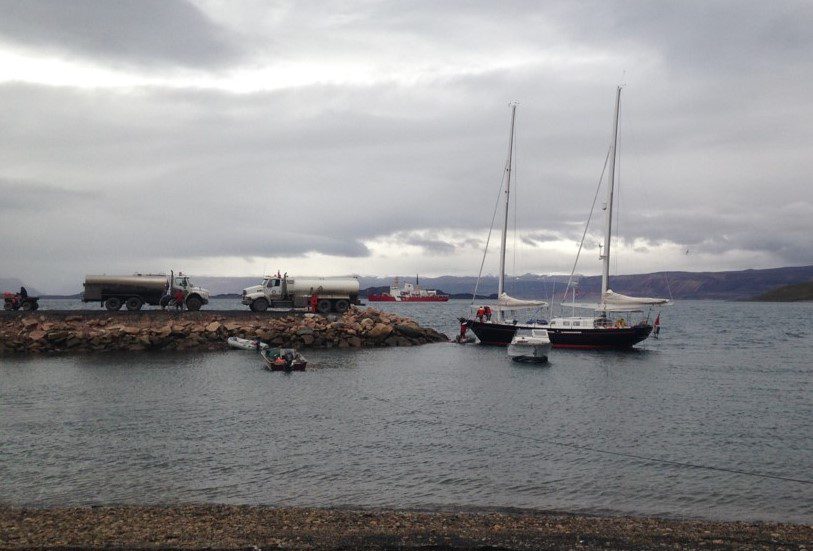Last Chance
Friday August 22, 2014 (73o 52’N 90o 18’W): Port Leopold
(Due North of New Orleans, 2600 Nautical Miles)
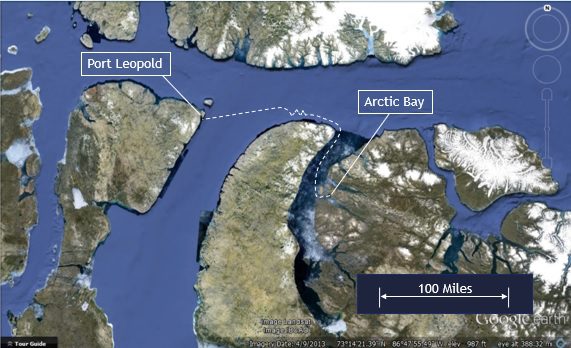
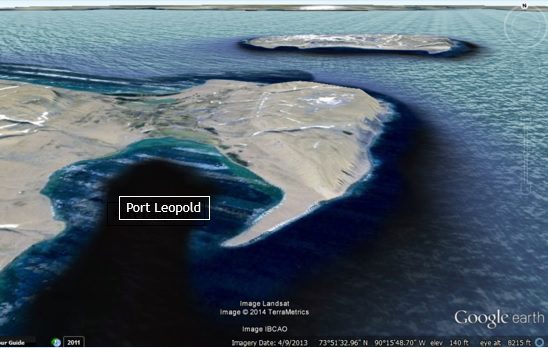
The Lillian B. will stay in the Arctic until August 28th for one last shot at making the passage this year. This decision is based on rapid changes in the ice conditions, plus the experience and optimism of two different sources: Les and Ali on Arctic Tern, and Douglas Pohl, in Everett Washington.
Arctic Tern was the boat that literally threw us a line in the inner harbor of Nuuk, Greenland and have provided us with critical advice and information along our way. Together, Les and Ali attempted the passage last year but had the good judgment to turn back when the conditions weren’t favorable. In approaching the Northwest Passage, Arctic Tern exhibits a patience and understanding of the conditions born of experience. In contrast, Lillian B has been more like a novice runner who starts out too fast in the first mile of the race before panting and finally settling down into a reasonable pace. So we now watch the pace of Arctic Tern very carefully and they have been very open and generous in sharing what they think is the best chance to get through.
The second source, Douglas Pohl is an Ocean Master with three circumnavigations and voluntarily helps mariners regarding the Northwest Passage. He had been following our blog from his home in Everett Washington, apparently eager to offer advice, but with no way to contact us directly. In Arctic Bay, we shared the harbor with the yacht Novara**, whose captain and crew have been consulting with Douglas and provided his contact information. With internet access for the first time since Nuuk Greenland, we were able to establish lines of communication with Douglas, and he has since been providing very specific and useful recommendation via our satellite e-mail link.
While understanding that the decision is ultimately ours, the fact that two independent and knowledgeable resources have similar opinions and approaches has help lead us to the conclusion that it is worth going the next step, which is to get down to Fort Ross. Fort Ross [ 72 00 N / 94 13 W ] sits at the east end of Bellot Strait, connecting Prince Regent Sound with Franklin Strait and would put us in position for a transient if and when the ice opens up in Franklin Strait. With that in mind, Wednesday August 20, the same day that crew member Dave Johanson caught his flight home, Pete and I pulled up the anchor and left Arctic Bay, headed for Port Bowen as in intermediary stop on the way south.
The next thirty six hours were tough. The weather was not as predicted and we ending beating westward against cold waves and gale force wind. With little sleep, we tried different watch routines, staying on watch as long as possible to allow the other to catch a block of sleep, but even with excellent foul weather gear, an arctic mix of driving snow and rain gets cold very quickly. Two hours on watch was as much as we could stand. We were making less than 2 miles an hour in the direction we wanted to go, even with a combination of motor and sail. Thursday evening, being cold and tired, we abandoned any attempt to round the point of Brodeur Peninsula in to Prince Regent Inlet and on to Port Bowen. At the same time, we received an email from Douglas saying that the winds were moving the ice against the eastern shore of Prince Regent Inlet and that we should try to head further west, on to Port Leopold, on Somerset Island, on the western shore. Unfortunately, west was the direction we couldn’t go. With no nearby harbor to wait out the wind, the best solution was to set up the Monitor, our wind vane driven auto-pilot. Pete set it up heading as close as possible in the direction we wanted to go. That ending up being more north than west, but we didn’t care. The auto-pilot was doing the driving, so the watchman could huddle behind the protection of the dodger, extending the watch time to three hours, while the other crewmember slept. At that point, slept was more important than progress.

The Monitor auto pilot is a combination of pulleys, hydrofoil, and wind vane that attaches to the helm via two lines, making it look as if we were ready to hang laundry in the cockpit. An advantage of a wind-vane auto pilot, over a hydraulic system is that the wind vane system responds to the wind as opposed to following a fixed prescribed electronic heading. If the wind changes, the auto pilot follows it. When trying to sail as close into the wind as possible, that is an important distinction, and one that worked in our favor throughout the night. As the winds shifted from the west around to the south, the Monitor gradually turned west. Come morning we were headed directly for Port Leopold, as if the elves had been at work.
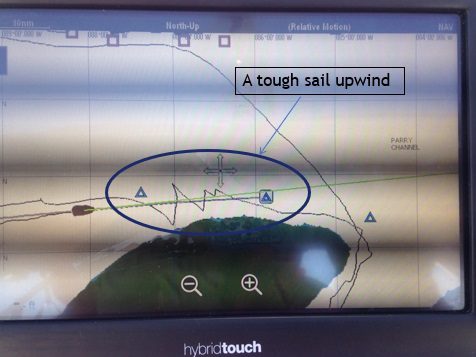
At around 0500 the winds rapidly died out and the seas became calm, just as we approached the ice fields off Somerset Island. Under those ideal conditions for negotiating the ice, we motored the last 25 miles in to Port Leopold, occasionally have to weave or bully our way through coalesced patches of melting ice. Around 0500 we also received an e-mail a message that Arctic Tern had arrived earlier that morning in Port Leopold. By 1130 we were securely anchored in the bay, had checked in with Les and crew, and fallen into our bunks.
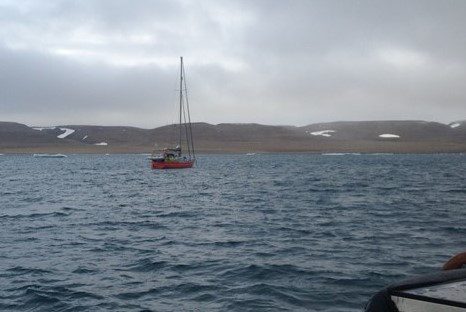
It is now 1800. In order to take advantage of the current weather, Arctic Tern left the harbor shortly after noon and is now progressing down the east coast of Somerset Island toward Port Ross. They have promised to send back reports on the ice conditions. Depending on today’s charts and their reports, we may follow as early as tonight. Given how quickly conditions change in the Arctic, it is advisable to take advantage when possible. Early this afternoon, as we relaxed, we overheard the yachts Drina and Catryn on the VHF and radio asking for conditions, which we have been able to share. Catryn just finished anchoring nearby, and Drina is reportedly an hour or two away. By luck or by design, it seems to be a case of convergent evolution, as the remaining boats attempting the NWP converge on Fort Ross. Nice to have company.
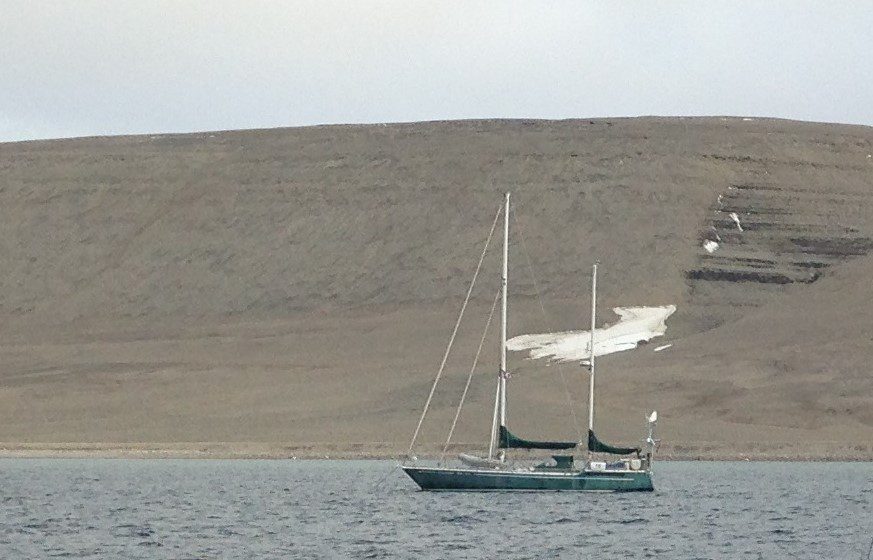
**As an aside, there were two other NWP yachts who shared the anchorage in Arctic Bay while we were there. The first was Gjoa, a couple who plans to winter over, and the second was Novara. Novara, of UK registry, is an impressive high-tech looking schooner with an unconventional rig that has fixed booms protruding fore and aft of the masts. Coincidentally, the port where she spent over three months in preparation for the Northwest Passage is Camden Maine. Camden Maine is a two mile jog from Lillian B.’s home port, Rockport Maine. Camden was also the home of the “original” Lillian B. Schueler, my grandmother, after whom the boat is named. Small world, even in the arctic.
